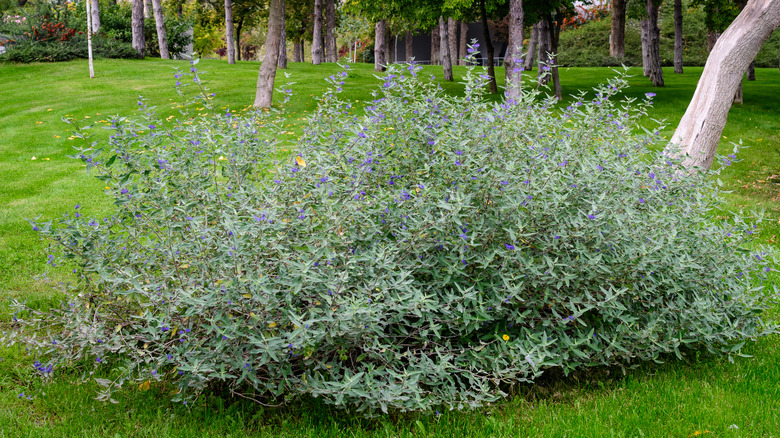With its beautiful blue and purple flowers, you’ll find that adding bluebeard (Caryopteris) to your property is well worth the investment. If you plant bluebeard in the right locations including along your property line, in your pollinator garden, or along a fence, you’ll not only add beauty to your yard but also attract some outstanding birds while you do so. The delicious scent of the blooms is what draws the birds (especially hummingbirds) in, and they’ll stick around for the nectar.
This flowering plant does best in full sun and in USDA hardiness zones 5 through 9. It’s easy to maintain and drought-tolerant, so it may be a better option than hanging bird feeders around your property to attract feathered friends. Further, while bluebeard encourages birds to come close, it’s also a nice little tool to keep deer out of your yard. Rabbits don’t like it either, which means the blooms can last longer than others, since these critters won’t take a few bites out of the flowers. Additionally, since bluebeard will continue to flower into the late fall even after other plants have stopped blooming, its benefits will extend beyond just the summer season.
Use bluebeard as a barrier and in a pollinator garden

One of the best ways to use bluebeard is as a barrier or border-like shrub along your property line. It doesn’t get tall enough to block out the visuals beyond your yard (it only grows to about 3 to 4 feet in height), but it can work very well as a type of outline for your space. Further, if you plant these shrubs along the edge of your property, they’ll help draw in birds who haven’t visited your yard before. For example, if you have a forested area beyond your home, plant these shrubs near the woods to draw out the birds that tend to lurk within the more dense trees. You can also use a row of this blooming shrub to create a formal designation line between your yard and that of the neighbor.
The second way to use this plant is as an attractant in a pollinator garden, as this can help support the growth of neighboring flowers and vegetables. They bring in not only birds but also butterflies and bees, so your garden is sure to benefit from this addition. Further, because they only grow just about 2 feet wide, they won’t crowd out the other plants in your pollinator garden, meaning that you can add lots of variety and color to a small space.
Add vibrance and attract birds at your fence line
The third way to use bluebeard to bring in birds is along your fence line. If you put up a fence to keep other critters like deer out, this may lead to fewer birds in your yard as well, since they won’t be able to see the beautiful blooms in your space. However, because the scent of bluebeard is what draws them in, birds will still be able to find the flowers. Bluebeard can also brighten up your fence, which may be particularly beneficial if you don’t love the look of your fence or wish it had a pop of color.
If you don’t want to plant anything directly next to the fence, consider using a few large urns or planters along the edges. There are some dwarf versions of bluebeard that can do very well in a planter, and these come with the benefit of being mobile, so you can easily change up your layout later on. Further, containers can add height to these short shrubs. You could place one right in the corner of your fence to add visual interest to your space so you can watch the birds enjoy the flowers. Potted versions can be placed on patios and decks too, but spaces that are further away from the home, like along your fence, will encourage more birds to visit.